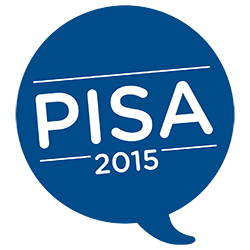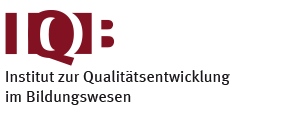Programme for International Student Assessment 2015 (PISA 2015)
Sie haben diese Studie mit einer veralteten DOI-Kennung aufgerufen. Die nachfolgenden Informationen beziehen sich auf die aktuelle Version. Sollten Sie Informationen zur älteren Version suchen oder diese älteren Daten anfordern wollen, wenden Sie sich bitte direkt an das FDZ mit Hinweis auf die DOI "10.5159/IQB_PISA_2015_v2"!

Inhaltsverzeichnis
Hinweise zur Nutzung der Daten
> Scientific Use Files beantragen
| Datensatz veröffentlicht am | 05.02.2019 |
|---|---|
| Version | v3 |
| aktuelle Version verfügbar seit | 25.01.2021 |
| Erhebungszeitraum | 2015 |
| Stichprobe | Schüler*innen (15-jährig) (N=ca. 6.500) sowie der Jahrgangsstufe 9 (N=ca. 4.100) an allgemeinbildenden Schulen (N=255); Lehrkräfte (N=5.600) |
| Erhebungseinheit | Eltern Lehrkräfte Schüler*innen Schulleitung |
| erfasste Kompetenzen | Naturwissenschaften, Mathematik, Deutsch - Leseverständnis, Problemlösekompetenz |
| Region | deutschlandweit, Baden-Württemberg, Bayern, Berlin, Brandenburg, Bremen, Hamburg, Hessen, Mecklenburg-Vorpommern, Niedersachsen, Nordrhein-Westfalen, Rheinland-Pfalz, Saarland, Sachsen, Sachsen-Anhalt, Schleswig-Holstein, Thüringen |
| Datengebende | Konferenz der Kultusminister (KMK) Reiss, Prof. Dr. Kristina |
| Auftraggebende / Mittelgebende | Kultusministerkonferenz (KMK), Organisation für wirtschaftliche Zusammenarbeit und Entwicklung (OECD) |
| Link zur Studie | https://www.pisa.tum.de/pisa/pisa-2000-2018/pisa-2015/ |
| Verwandte Studien | PISA 2000 (DOI: 10.5159/IQB_PISA_2000_v1), PISA 2003 (DOI: 10.5159/IQB_PISA_2003_v1), PISA 2006 (DOI: 10.5159/IQB_PISA_2006_v1), PISA 2009 (DOI: 10.5159/IQB_PISA_2009_v1), PISA 2012 (DOI: 10.5159/IQB_PISA_2012_v5), PISA 2018 (DOI: 10.5159/IQB_PISA_2018_v1), PISA-I-Plus 2003-4 (DOI: 10.5159/IQB_PISA_I_Plus_v1), PISA Plus 2012-13 (DOI: 10.5159/IQB_PISA_Plus_2012-13_v2) |
| Zitationsvorschlag | Reiss, K., Sälzer, C., Schiepe-Tiska, A., Mang, J., Heine, J.-H., Weis, M., Klieme, E. & Köller O. (2019). Programme for International Student Assessment 2015 (PISA 2015) (Version 3) [Datensatz]. Berlin: IQB – Institut zur Qualitätsentwicklung im Bildungswesen. http://doi.org/10.5159/IQB_PISA_2015_v3 |
| Datenrestriktion / Zugangshinweise | Kognitive Grundfähigkeiten dürfen nicht als abhängige Variable in den Analysen verwendet werden. |
Projektbeschreibung
Mit Durchführung des Programme for International Student Assessment (PISA) 2015 liegen die Ergebnisse aus der sechsten Erhebungsrunde vor, bei der 2015 die Naturwissenschaften im Mittelpunkt stehen. Damit ist der zweite Zyklus der Studie (2000-2006, 2009-2015) abgeschlossen, so dass jede der drei untersuchten Grundbildungsdomänen Lesen, Mathematik und Naturwissenschaften zweimal den inhaltlichen Schwerpunkt bildete. Die fünfzehnjährigen Schüler*innen bearbeiteten Aufgaben aus den Bereichen Naturwissenschaften, Mathematik, Lesen und kollaboratives Problemlösen sowie einen Fragebogen zum demographischen Hintergrund und dem Unterrichts- und Schulgeschehen. Befragt wurden außerdem die Schulleitungen, Lehrkräfte und Eltern. Auf nationaler Seite wurde die Untersuchung von einer Arbeitsgruppe am Zentrum für internationale Bildungsvergleichsstudien (ZIB e. V.) unter Leitung von Prof. Dr. Kristina Reiss an der School of Education der Technischen Universität München (TUM) durchgeführt. Die wichtigste Änderung für die Testteilnehmer*innen bestand in der Umstellung auf computerbasiertes Testen. Außerdem wurde in PISA 2015 ein verfeinertes Modell zur Skalierung der Daten verwendet, welches neben der Schwierigkeit der Testaufgaben und der Fähigkeit der Jugendlichen auch das Potenzial von Testaufgaben berücksichtigt, tatsächlich kompetente von weniger kompetenten Schüler*innen zu unterscheiden. (Projekt/IQB)
Zu beachten:
IQB-Ländervergleiche seit 2009 als eigenständige Studien
Bei Anträgen auf die PISA-Daten der Erhebungen 2000, 2003 und 2006 werden jeweils die deutschen Datensätze aus der internationalen und der nationalen Ergänzungsstudie (PISA-I bzw. PISA-E) gemeinsam ausgeliefert. Seit der Erhebung im Jahr 2009 wurden die nationalen Ergänzungsstudien (PISA-E) durch die IQB-Ländervergleiche abgelöst, die parallel zu den internationalen PISA-Erhebungen stattfinden. Die Daten der IQB-Ländervergleiche seit 2009 werden zwar nicht automatisch mit den Daten der internationalen PISA-Studien ausgeliefert, sind aber auf Antrag ebenfalls am Forschungsdatenzentrum des Instituts zur Qualitätsentwicklung im Bildungswesen erhältlich. Weitere Informationen zu den IQB-Ländervergleichen finden Sie hier und hier.
Leerdatensätze
Um Ihnen einen ersten Überblick der Datensätze zu vermitteln, haben Sie hier die Möglichkeit, Leerdatensätze herunterzuladen.
- PISA 2015 Daten Lehrkräfte (SPSS)
- PISA 2015 Daten Schüler/Eltern - 9. Klasse (SPSS)
- PISA 2015 Daten Schüler/Eltern - 15 Jahre (SPSS)
- PISA 2015 Daten Schulleitung (SPSS)
- PISA 2015 Daten Schüler Timing (SPSS)
Dokumentation
Hier finden Sie weiterführendes Material zur Studie:
Weiterführende Informationen
 Hier finden Sie zentrale Ergebnisse der PISA-Studie 2015.
Hier finden Sie zentrale Ergebnisse der PISA-Studie 2015.- Berichte in deutscher, englischer und französischer Sprache stehen auch auf der PISA-Website der OECD zum Download zur Verfügung.
 Hinweise zu den Daten
Hinweise zu den Daten
Hinweise zur Nutzung der Daten
Sind die Kompetenzschätzer der PISA-, IGLU- und IQB-LV/BT-Studien miteinander vergleichbar?
Prinzipiell korrelieren die Tests aus PISA und den IQB-Ländervergleichen bzw. IQB-Bildungstrends hoch, aber die zugrunde liegenden Kompetenzmodelle unterscheiden sich. Die IQB-Tests sind an den Bildungsstandards der KMK und damit stärker am Curriculum orientiert als die PISA-Tests. Eine Testung der Vergleichbarkeit ist möglich mit IRT-Methoden auf Basis von Studien, in denen sowohl PISA als auch IQB-LV/IQB-BT Items verwendet wurden. Einige Studien zum Vergleich sind z. B.:
 Jude, Nina [Hrsg.]; Klieme, Eckhard [Hrsg.]: PISA 2009 - Impulse für die Schul- und Unterrichtsforschung. Weinheim u.a. : Beltz 2013, S. 200-228. - (Zeitschrift für Pädagogik, Beiheft; 59)
Jude, Nina [Hrsg.]; Klieme, Eckhard [Hrsg.]: PISA 2009 - Impulse für die Schul- und Unterrichtsforschung. Weinheim u.a. : Beltz 2013, S. 200-228. - (Zeitschrift für Pädagogik, Beiheft; 59)- Hartig, Johannes; Frey, Andreas: Validität des Tests zur Überprüfung des Erreichens der Bildungsstandards in Mathematik. Göttingen: Hogrefe 2012, S. 3-14. - (Diagnostica, Jahrgang 58, Heft 1) - https://doi.org/10.1026/0012-1924/a000064
 van den Ham, Ann-Katrin; Ehmke, Timo; Hahn, Inga; Wagner, Helene; Schöps, Katrin: Mathematische und naturwissenschaftliche Kompetenz in PISA, im IQB-Ländervergleich und in der National Educational Panel Study (NEPS) – Vergleich der Rahmenkonzepte und der dimensionalen Struktur der Testinstrumente - In: Bundesministerium für Bildung und Forschung [Hrsg.]: Forschungsvorhaben in Ankopplung an Large-Scale-Assessments. Stand August 2016. Berlin : Bundesministerium für Bildung und Forschung 2016, S. 140-160 - URN: urn:nbn:de:0111-pedocs-126776
van den Ham, Ann-Katrin; Ehmke, Timo; Hahn, Inga; Wagner, Helene; Schöps, Katrin: Mathematische und naturwissenschaftliche Kompetenz in PISA, im IQB-Ländervergleich und in der National Educational Panel Study (NEPS) – Vergleich der Rahmenkonzepte und der dimensionalen Struktur der Testinstrumente - In: Bundesministerium für Bildung und Forschung [Hrsg.]: Forschungsvorhaben in Ankopplung an Large-Scale-Assessments. Stand August 2016. Berlin : Bundesministerium für Bildung und Forschung 2016, S. 140-160 - URN: urn:nbn:de:0111-pedocs-126776
Das Ausmaß der Vergleichbarkeit muss für die Lese- und Mathematikkompetenzen sowie für die Sekundarstufe und Grundschule getrennt betrachtet werden. Auch wenn man davon ausgehen kann, dass sich Länderunterschiede mit beiden Maßen gut abbilden lassen, ist die Analyse von absoluten Trends auf einer gemeinsamen Metrik aber leider nicht möglich.
Die Datensätze der Studien PISA 2012 und IQB-Ländervergleich 2012 lassen sich über die ID-Variable [idstud_FDZ] miteinander verknüpfen. Dadurch können Sie Zusammenhänge zwischen den skalierten Testwerten beider Studien miteinander vergleichen.
Beachten Sie bitte zusätzlich:
1.) Anders als in den PISA-Erhebungen werden Lese- und Mathematikkompetenz in den IQB-Studien nur in der Grundschule gemeinsam getestet: Die Lesekompetenzen wurden im IQB-Ländervergleich 2009 (Sekundarstufe I) und im IQB-Ländervergleich 2011 (Grundschule) sowie im IQB-Bildungstrend 2015 (Sekundarstufe I) und im IQB-Bildungstrend 2016 (Grundschule) erfasst. Die Mathematikkompetenzen können Sie dem IQB-Ländervergleich 2012 (Sekundarstufe) und IQB-Ländervergleich 2011 (Grundschule) sowie dem IQB-Bildungstrend 2016 (Grundschule) und dem IQB-Bildungstrend 2018 (Sekundarstufe) entnehmen.
2.) Wenn Sie Analysen durchführen möchten, die unveröffentlichte, neuartige Vergleiche zwischen einzelnen Bundesländern beinhalten, gilt laut unserer Verfahrensordnung ein erweitertes Antragsverfahren mit Reviewprozess.
Gibt es in den IQB-Ländervergleichen/Bildungstrends sowie in PISA die Möglichkeit, eine (tagesgenaue) Erfassung des Alters der Schüler*innen vorzunehmen?
Angaben zum Geburtsjahr und Geburtsalter der Schüler*innen werden standardmäßig in den IQB-Ländervergleichen und PISA-Studien erhoben und stehen für Re- und Sekundäranalysen der Daten zur Verfügung. Tagesgenaue Angaben zum Geburtsdatum wurden aus datenschutzrechtlichen Gründen allerdings nicht erfasst und liegen in den Datensätzen nicht vor. Auch das genaue Testdatum ist in den meisten Datensätzen nicht enthalten (in PISA 2009 liegen diese Angaben vor). Häufig ist in den Datensätzen aber eine Altersvariable enthalten, die unter Verwendung des Geburtsjahrs und -monats in Relation zum Testdatum gebildet wurde (z. B. in den IQB-Ländervergleichen 2011, 2012 sowie in PISA 2012, 2009, 2006).
Welche nationalen PISA-Daten lassen sich mit den IQB-Ländervergleichen/Bildungstrends oder den internationalen PISA-Daten verknüpfen?
Die PISA-2012-Datensätze lassen sich mit den Daten des IQB-Ländervergleichs 2012 kombinieren. Die Schüler*innen-IDs wurden in den am FDZ am IQB verfügbaren Datensätzen schon so rekodiert, dass eine Verknüpfung beider Datenquellen möglich ist. Eine Verknüpfung der anderen PISA-Wellen mit den Daten der IQB-Ländervergleichen/IQB-Bildungstrends ist leider nicht möglich, da sich die ID-Variablen nicht einheitlich rekodieren lassen.
Auf welchen Ebenen wurden die Deutschland-PISA-Daten erfasst?
In den deutschen PISA-Studien liegen lediglich Informationen auf Bundeslandebene vor. Bitte beachten Sie, dass bei der Analyse von Bundesland-Daten besondere Nutzungsbedingungen eingehalten werden müssen. Diese können Sie hier nachlesen:
 Verfahrensordnung Stand: 31.01.2019
Verfahrensordnung Stand: 31.01.2019 Verfahrensordnung - neuartige Ländervergleiche Stand: 31.01.2019
Verfahrensordnung - neuartige Ländervergleiche Stand: 31.01.2019
Wie hoch ist die Anzahl der gezogenen Klassen pro Schule in PISA-Erhebungen?
Informationen zur Stichprobenziehung in den Studien finden Sie in den Ergebnisberichten bzw. Skalenhandbüchern.
Hier eine kurze Zusammenfassung zur Stichprobenziehung in PISA:
PISA 2000:
zufällige Auswahl von 28 15-Jährigen sowie 10 nicht 15-Jährigen Neuntklässlern pro Schule; es wurden also nicht vollständige Klassen gezogen, Analysen können nur auf Schulebene durchgeführt werden
PISA 2003:
zufällige Auswahl von 15-Jährigen pro Schule; zusätzlich wurden für die nationale Erweiterung zwei komplette 9. Klassen pro Schule gezogen; in den PISA-E-Daten wurde allerdings keine klassenbasierte Stichprobenziehung realisiert.
PISA 2006:
schulbasierte Stichprobenziehung, anschließend zufällige Auswahl von 15-Jährigen pro Schule, an den Schulen der internationalen Stichprobe (PISA_I) wurden zusätzlich Schüler*innen aus zwei kompletten 9. Klassen getestet
PISA 2009:
schulbasierte Stichprobenziehung, zusätzlich wurden Schüler*innen aus zwei kompletten 9. Klassen pro Schule getestet
PISA 2012:
schulbasierte Stichprobenziehung, zusätzlich wurden Schüler*innen aus zwei kompletten 9. Klassen pro Schule getestet
PISA 2015:
schulbasierte Stichprobenziehung, anschließend zufällige Auswahl von 15 Schüler*innen einer 9. Klasse innerhalb einer Schule
PISA 2018:
schulbasierte Stichprobenziehung, anschließend zufällige Auswahl von 15 Schüler*innen einer 9. Klasse innerhalb einer Schule
Wie viele Schüler*innen an Förder- und Berufsschulen sind in den PISA-Daten enthalten?
Die Förder- und Berufsschüler*innen wurden in den genannten PISA-Erhebungen getrennt erfasst. Nachfolgend finden Sie die Stichprobenumfänge für diese Teilgruppen. Sie basieren auf den Angaben in den deutschen PISA-Erweiterungsstichproben (PISA-E) in den Schüler*innen- und Schulleitungsdatensätzen. Gegebenenfalls kann es zu leichten Abweichungen zu den berichteten Stichproben in den Ergebnisberichten kommen.
PISA 2000 E:
- 9. Klasse: n= 11 Schüler*innen an Berufsschulen, n= 22 Schüler*innen an Förderschulen von insgesamt n = 34.754 Schüler*innen
- 15-Jährige: n= 241 Schüler*innen an Berufsschulen, n= 799 Schüler*innen an Förderschulen von insgesamt n= 35.584 Schüler*innen
- Schuldatensatz: n= 18 Berufsschulen, n= 4 Förderschulen von insgesamt n= 1.342 Schulen
PISA 2003 E (hier keine Differenzierung zwischen Datensätzen für 9. Klasse & 15-Jährige möglich)
- 9. Klasse: n= 654 Schüler*innen an Berufsschulen, n= 1.712 Schüler*innen an Förderschulen von insgesamt n= 46.185 Schüler*innen
- Schuldatensatz: n= 43 Berufsschulen, keine Förderschulen von insgesamt n= 1.411 Schulen
PISA 2006 E:
- 9. Klasse: keine Schüler*innen an Berufsschulen oder Förderschulen im Datensatz
- 15-Jährige: n= 625 Schüler*innen an Berufsschulen, n= 2.560 Schüler*innen an Förderschulen von insgesamt n= 39.573 Schüler*innen
- Schuldatensatz: n= 42 Berufsschulen, keine Förderschulen von insgesamt n= 1.496 Schulen
PISA 2009 E:
- 9. Klasse: keine Schüler*innen an Berufsschulen oder Förderschulen im Datensatz von insgesamt n= 9.461
- Schuldatensatz: n= 9 Berufsschulen, n= 13 Förderschulen von insgesamt n= 226 Schulen
PISA 2012 E:
- 9. Klasse: keine Schüler*innen an Berufsschulen, n= 153 Schüler*innen an Förderschulen im Datensatz von insgesamt n= 9.998 Schüler*innen
- 15-Jährige: n= 99 Schüler*innen an Berufsschulen, n= 139 Schüler*innen an Förderschulen im Datensatz von insgesamt n= 5.001 Schüler*innen
- Schuldatensatz: n= 7 Berufsschulen, n= 12 Förderschulen von insgesamt n= 230 Schulen
PISA 2015 E:
- 9. Klasse: keine Schüler*innen an Berufsschulen, n= 165 Schüler*innen an Förderschulen im Datensatz von insgesamt n= 4.149 Schüler*innen
- 15-Jährige: n= 160 Schüler*innen an Berufsschulen, n= 134 Schüler*innen an Förderschulen im Datensatz von insgesamt n= 6.504 Schüler*innen
- Schuldatensatz: n= 8 Berufsschulen, n= 12 Förderschulen von insgesamt n= 205 Schulen
PISA 2018 E:
- 9. Klasse: keine Schüler*innen an Berufsschulen, n= 115 Schüler*innen an Förderschulen im Datensatz von insgesamt n= 3.567 Schüler*innen
- 15-Jährige: n= 184 Schüler*innen an Berufsschulen, n= 98 Schüler*innen an Förderschulen im Datensatz von insgesamt n= 5.451 Schüler*innen
- Schuldatensatz: n= 10 Berufsschulen, n= 7 Förderschulen von insgesamt n= 191 Schulen
Lassen sich Lehrkräfte- und Schüler*innendaten in PISA verknüpfen?
Leider ist eine Verknüpfung nur für die Teildatensätze der 9. Klässler*innen möglich (die Datensätze der 15-Jährigen umfassen schulübergreifende Stichproben). In den meisten PISA-Wellen wurden zwei 9. Klassen gezogen, aber in den Teildatensätzen fehlt häufig eine eindeutige Klassen-ID.
Hier eine Übersicht in Stichpunkten zu den einzelnen PISA-Wellen:
PISA 2000:
hier wurde kein Lehrkräfte-Fragebogen eingesetzt
PISA 2003:
Teildatensatz "PISA-I-9.Klasse": Lehrkräfte-Fragebögen beinhalten Fragen auf Schulebene, nicht auf Klassenebene; eine Verknüpfung über die Variable [idclass_FDZ] ist möglich, aber im Lehrkräftedatensatz gibt es auf dieser Variable einen hohen Anteil fehlender Werte (vermutlich, da viele Lehrkräfte pro Schule befragt wurden); Teildatensatz "PISA-E": keine Lehrkräftefragebogen vorhanden
PISA Plus 2003-2004:
eine Verknüpfung ist prinzipiell möglich, aber Lehrkräftedaten müssten aus PISA-2003-Daten herangespielt werden und liegen nur zum ersten Messzeitpunkt vor
PISA 2006:
Teildatensatz "PISA-E": kein Lehrkräftedatensatz für 9.Klassen vorhanden, Verknüpfung nur auf Schulebene möglich; Teildatensatz "PISA-I": keine eindeutige Verknüpfung möglich, da im Lehrkräftedatensatz keine Klassen-ID enthalten ist
PISA 2009:
ebenfalls keine Klassen-ID im Lehrkräftedatensatz, aber Verknüpfung über idsch und Variable [LF39M01] (Deutsch in PISA Klasse unterrichtet: ja vs. nein) teilweise möglich; es wurden allerdings pro Schule zwei 9. Klassen gezogen
PISA 2012:
Verknüpfung ist prinzipiell über Variablen zur Klassenbezeichnung möglich (Lehrkräfte-Datensatz: klasse_FDZ; Schüler*innendatensatz: ClassName_FDZ) aber praktisch schwierig zu bewerkstelligen, da Metrik der Schul-ID zwischen beiden Teildatensätzen nicht korrespondiert und auf Variablen zur Klassenbezeichnung hoher Anteil fehlender Werte vorliegt (Erfahrungsberichte der PISA-Mitarbeiter*innen interpretiere ich so, dass Verknüpfung in Mehrheit der Fällen nicht gelingt)
PISA 2015:
Verknüpfung ist nicht direkt möglich, da alle Lehrkräfte der gezogenen Schulen befragt wurden
PISA 2018:
Eine Zuordnung zwischen Lehrkräften und Schüler*innen über die Variable "TEACHCLASS_ID" ist bis Ende 2022 aufgrund eines Sperrvermerks nicht möglich. Diese Variable beinhaltet aber auch nur die Information, ob die Lehrkraft eine neunte Klasse unterrichtet hat oder nicht. Das liegt daran, dass nahezu alle Lehrkräfte in der gezogenen Schule befragt wurden. Alternativ kann die Variable "TEACHERID" verwenden werden, aber auch diese Variable ermöglicht keine eindeutige Zuordnung zwischen Schüler*innen und dazugehöriger Lehrkraft.
Für welche PISA-Daten liegt ein Messwiederholungsdatensatz vor?
Ein Messwiederholungsdatensatz liegt für PISA-2003 (PISA-Plus 2003, 2004) und PISA-2012 (PISA-Plus 2012, 2013)
Wie wurden die Tests zur naturwissenschaftlichen Kompetenz in PISA entwickelt?
Im Gegensatz zu den IQB-Ländervergleichen sind die naturwissenschaftlichen Tests in PISA nicht curricular verankert bzw. fachspezifisch konzipiert. Deshalb gibt es in PISA keine Subtests für Biologie, Physik und Chemie. Vielmehr wird in PISA eine naturwissenschaftliche Grundbildung (Scientific Literacy, siehe z. B. OECD, 2006) getestet. Dabei handelt es sich um Fähigkeiten, die in Situationen bedeutsam sind, in denen man mit Naturwissenschaften und Technik konfrontiert ist. Diese Situationen beziehen sich auf physikalische Systeme, lebende Systeme, Erd- und Weltraumsysteme und technologische Systeme. Konkret werden die folgenden Kompetenzen getestet:
a) naturwissenschaftliche Fragestellungen erkennen
b) naturwissenschaftliche Phänomene beschreiben, erklären und vorherzusagen
c) naturwissenschaftliche Evidenz nutzen, um Entscheidungen zu treffen
Nähere Informationen zur Konzeption und zum Test (inklusive Beispielaufgaben) finden Sie hier:
- OECD 2015 Assessment / Framework
- PISA Scientific Literacy
 OECD: How PISA measures science literacy
OECD: How PISA measures science literacy- in diesem Ergebnisbericht (für Deutschland) sowie hier
- Prenzel, M., Artelt, C., Baumert, J., Blum, W., Hammann, M., Klieme, E., Pekrun, R. (Hrsg.) (2008). PISA 2006 in Deutschland : Die Kompetenzen der Jugendlichen im dritten Ländervergleich. Münster: Waxmann.
Wofür stehen die Endungen "TA" und "NA" in den Variablennamen des Schüler*innenfragebogens in PISA 2015?
Die Endungen im Schüler*innenfragebogen indizieren Folgendes:
- "TA": Es handelt sich um ein Trendanalyse-Item, welches in dieser Form schon mindestens einmal in einer vorherigen PISA-Welle lief.
- "NA": Diese Endung zeigt an, dass dieses Item noch nie in einem vorherigen PISA-Zyklus zum Einsatz kam.
Nähere Informationen zur Itembenennung findet sich  hier (z. B. Fußnote 4) sowie im Technischen Bericht zur PISA 2015-Studie.
hier (z. B. Fußnote 4) sowie im Technischen Bericht zur PISA 2015-Studie.
Sind Lehrkräfte- und Schüler*innendatensatz in PISA 2015 verknüpfbar?
Leider ist keine genaue Zuordnung möglich, welche Lehrkraft welche/n Schüler*innen unterrichtet. Eine Verknüpfung auf Schulebene ist allerdings möglich.
Literatur
Eine Auswahl an Publikationen finden Sie in dieser  Literaturliste (Stand: 22.03.2023).
Literaturliste (Stand: 22.03.2023).
2019
Mang, J., Ustjanzew, N. & Leßke, I. (2019). PISA 2015 Skalenhandbuch. Dokumentation der Erhebungsinstrumente. Münster: Waxmann. Verfügbar unter https://www.iqb.hu-berlin.de/fdz/studies/PISA_2015/Skalenhandbuch_P.pdf
Reiss, K., Sälzer, C., Schiepe-Tiska, A., Mang, J., Heine, J.-H., Weis, M., Klieme, E. & Köller, O. (2019). Programme for International Student Assessment 2015 (PISA 2015) (Version 3) [Datensatz]. Berlin: IQB - Institut zur Qualitätsentwicklung im Bildungswesen. https://doi.org/10.5159/IQB_PISA_2015_v3
Zehner, F., Weis, M., Vogel, F., Leutner, D. & Reiss, K. (2019). Kollaboratives Problemlösen in PISA 2015: Deutschland im Fokus. Zeitschrift für Erziehungswissenschaft, 22(3), 617–646. https://doi.org/10.1007/s11618-019-00874-4
2017
OECD. (2017). PISA 2015 assessment and analytical framework. Science, reading, mathematic, financial literacy and collaborative problem solving. Revised edition (PISA). Paris: OECD Publishing. https://doi.org/10.1787/9789264281820-en
OECD. (2017). PISA 2015 Technical Report. Paris: OECD Publishing. Retrieved from http://www.oecd.org/pisa/data/2015-technical-report/
Zehner, F., Weis, M., Vogel, F., Leutner, D. & Reiss, K. (2017). Kollaboratives Problemlösen in PISA 2015: Befundhöhepunkte rund um Deutschland. München: Technische Universität München. https://doi.org/10.14459/2017md1401788
2016
Reiss, K., Sälzer, C., Schiepe-Tiska, A., Klieme, E. & Köller, O. (Hrsg.). (2016). PISA 2015. Eine Studie zwischen Kontinuität und Innovation. Münster: Waxmann. Verfügbar unter http://www.content-select.com/index.php?id=bib_view&ean=9783830985556

